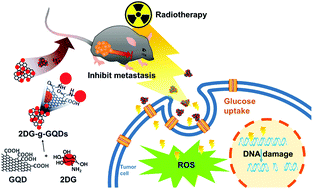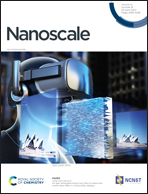One-stop radiotherapeutic targeting of primary and distant osteosarcoma to inhibit cancer progression and metastasis using 2DG-grafted graphene quantum dots†
Abstract
The application of radiotherapy (RT) to treat osteosarcoma (OS) has been limited, but this is starting to change as the ability to target radiation energy to niches improves. Furthermore, lung cancer from highly metastatic OS is a major cause of death, so it is critical to explore new strategies to tackle metastasis. In this study, we designed a nanoscale radiosensitizer by grafting 2-deoxy-D-glucose (2DG) onto graphene quantum dots (GQD) to achieve OS targeting and boost RT efficacy. Combining the use of 2DG-grafted GQDs (2DG-g-GQD) with RT produced a significant increase in oxidative stress response and DNA damage in the 143B OS cell line compared with RT alone. Moreover, 2DG-g-GQDs selectively associated with 143B cells, and demonstrated the inhibition of migration in a scratch assay. We also demonstrated remarkable improvement in their ability to inhibit tumour progression and lung metastasis in an OS xenograft mouse model. Our results show that the use of 2DG-g-GQDs as OS-targeting radiosensitizers improves their therapeutic outcome and exhibits potential for use in low-dose precision RT for OS.



 Please wait while we load your content...
Please wait while we load your content...